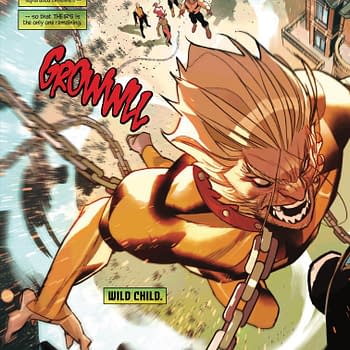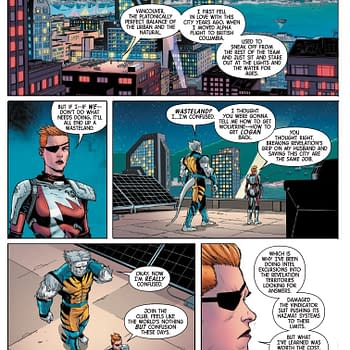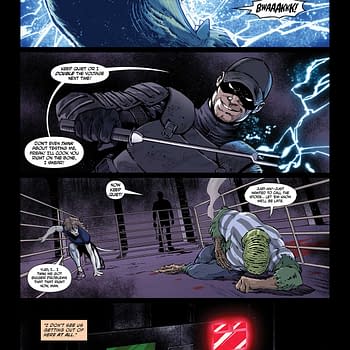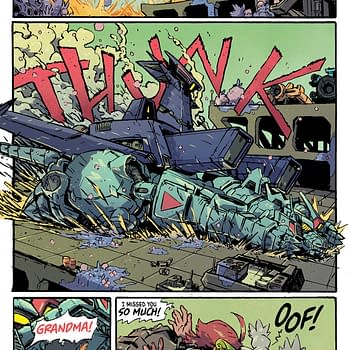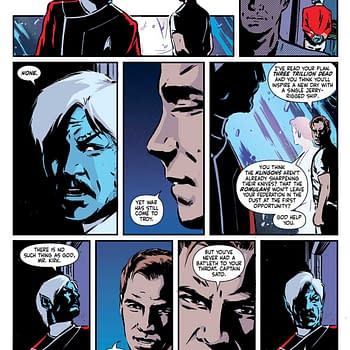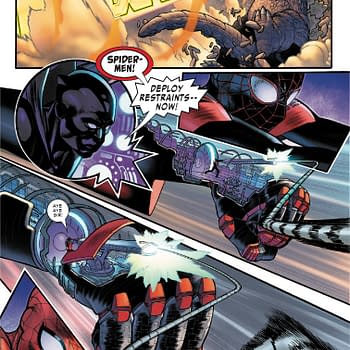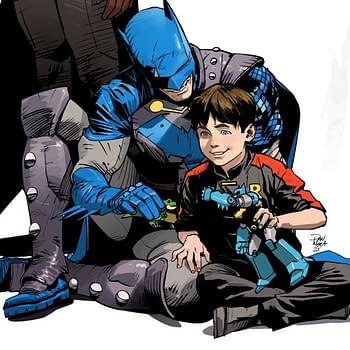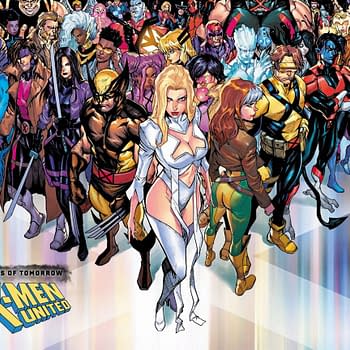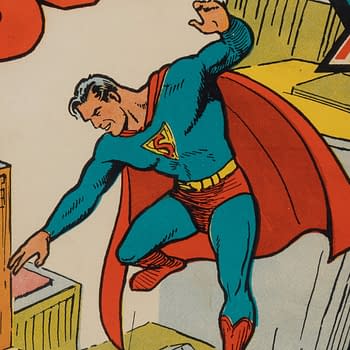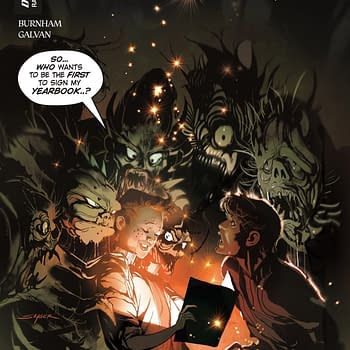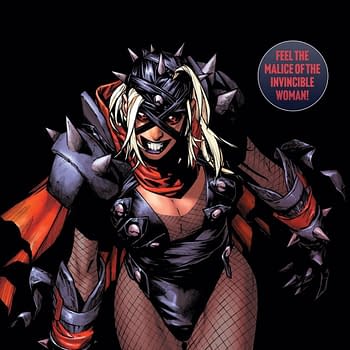Posted in: Comics | Tagged: Aubrey Sitterson, embargoed, gi joe, HRL, idw, scarlett's strike force
Aubrey Sitterson Talks Scarlett's Strike Force, The Influence Of Cartoons, And A Socialist Writing GI Joe
Coming out of IDW's Hasbro universe super-mega-crossover event, First Strike, GI Joe is getting a revamp as Scarlett's Strike Force, with writer Aubrey Sitterson collaborating with new series artist Nelson Daniel to prove that GI Joe is "the best action comic ever."
Bleeding Cool sat down with Sitterson to discuss his take on Joe, the property's progressive roots and cultural influence, and the apparently not so certain future of the series. Check out the full interview below.
Bleeding Cool: Since the start of your run, Scarlett has been the leader of a relatively small team of Joes. Why rebrand the book as Scarlett's Strike Force now?
Aubrey Sitterson: Coming out of the First Strike crossover, IDW wanted to clearly signal that even though we're building off what came before, the book was something different and, importantly, a good jumping on point for new readers. The buzz around the previous run (with amazing art by Giannis Milonogiannis, Lovern Kindzierski, Aaron Conley, and others) had been so positive, and the trades have been doing so well in bookstores that reaching out to new readers was a top priority for all of us. But instead of just another Joe series, the call was made to launch a brand-new title and I offered up a bunch of suggestions, most notably Sgt. Sitterson and his Screaming Eagles. IDW ended up going with Scarlett's Strike Force, which was, admittedly, probably the right call. They did, however, give me the thumbs-up on our new tag line and promise to you, the reader: THE BEST ACTION COMIC EVER.
BC: What changes have you made to your writing on Scarlett's Strike Force to tailor the comic more to the talents of new artist Nelson Daniel?
AS: Whenever I start a new project, I always ask my collaborators a pretty straightforward question: "What do you want to do?" Characters, settings, plot points — you name it. I can't always work it in, but when outlining, I like to have a big list of pie-in-the-sky stuff in case I can make it happen. This is something I asked not only Nelson, but Ilias Kyriazis (artist on the First Strike tie-ins) and I even chatted with our colorist Ryan Hill about his favorite Joes over beers one night in Highland Park. That's all relatively surface-level stuff, though.
The biggest change came in terms of what beats I emphasized. Giannis is a unique, incredible talent with a lot of action-heavy manga influence in his work, so that's something I leaned into heavily with our Joe run: A total shonen splash page of Quick Kick swinging his meteor hammer, cutesy-wutesy Fatal Fluffies. speedlines galore, etc. Nelson, however, while just as amazing as Giannis, is a very different talent.
In preparing for the book, I reread a bunch of his Dungeons & Dragons stuff with Jim Zub and got Carlos Guzman (my editor) to send me advance PDFs of his work with Paul Allor on Clue. What leapt out to me on both projects was Nelson's amazing ability to depict characters that had not only emotion, but full inner lives, all through the use of facial expressions and gestures — you can read his pages without lettering, which is a rare, rare skill. For a writer who generally eschews inner monologue captions, this was an incredible gift, and it's allowed me to really focus on exploring and paying off all the intra-team drama that we've developed this past year.
Oh yeah! Nelson also draws his own SFX. I don't really have to do anything different for that, it's just something I like a lot and wanted to tell you about.
BC: When you started your run on GI Joe, did you set out to make Skywarp and Rock and Roll, or SkyRock as I'm calling them, the definitive Hasbro-mance, or did it just happen naturally?
AS: Actually… yeah. It was totally intentional, so I can't tell you how much it thrills me that you and so many other folks have latched onto them and their weird relationship. From my first issue of Joe, the Revolution one-shot, in which Rock finds and rescues Skywarp, I've seen them as a buddy cop duo. Two guys who are very, very different, but with more in common than they'd probably like to admit, and a shared understanding that grows out of it. Their relationship is one of my favorite character arcs, and Skywarp finally letting Rock ride inside of him is one of my favorite moments I've ever written, in Joe or elsewhere.
BC: Larry Hama and his various artist partners' long-running GI Joe series, Real American Hero, has always featured some sci-fi elements — Doctor Venom's brainwave scanner, Serpentor, androids, etc. — but it's probably best known for the military background and details Hama brings to the comic. And, of course, ninjas. But your GI Joe has a smaller core team of Joes fighting shapeshifting aliens, rampaging underground mutants, dinosaurs. What made you want to do a GI Joe superhero comic?
AS: The decision came about for a bunch of different reasons. First up, Larry's Real American Hero is still ongoing, so there's no need for anyone to come in and do Hama-Lite. Absolutely no one wants that. Besides, I couldn't do what Larry does even if I wanted to and it would have been foolish of me to try.
Second, while I adore a lot of IDW continuity Joe, particularly the Cobra series, those books went about as far as you could go with realistic, gritty military Joe. I figured it was time for the pendulum to swing in the other direction, especially since the Joes were going to be operating in a world with giant robots, tiny extradimensional people and Spaceknights. And of course, that was just fine by me, seeing as my introduction to Joe, where I really fell in love with the characters, was the somewhat outlandish Sunbow series and the fully outlandish adventures I used to have with my action figures.
Not infrequently, my Joes would end up teaming up with and/or fighting my X-Men action figures, which in hindsight, is pretty fitting, as the Uncanny X-Men work of Claremont, Cockrum, Byrne, et al, is probably the single biggest comics influence on my Joe run. Figuring out how to update that approach — explosive, weird action with melodramatic soap opera — for 2017 was my big, overarching goal for the series, so I wear the "G.I Joe Superhero Comic" badge with pride.
BC: Another thing that sets your run on Joe apart from past takes is the extent to which many of the characters are suffering, angry, struggling with their identities and with guilt. What is it about torturing the Joes that makes for such compelling storytelling?
AS: I came onto this project wanting to do something aspirational and optimistic. Not only as a way of doing something different than what had come before, but because that was the Joe that I had always loved: A diverse group of unequivocally heroic people working together, having fun, making jokes and, in the end, defeating the bad guys. But the problem with that approach is that there's not a whole lot of conflict, which makes for the opposite of compelling storytelling.
A common solution is to really ratchet up the conflict between the heroes and we definitely do some of that – Quick Kick and Snake Eyes beat the bejeezus out of each other for a full half an issue, after all – but I didn't want to do too much of it, as it would work at crosspurposes with the idea that all of these people know, respect and care about one another. The way out was through internal drama. That's why every single one of the core cast has something gnawing away at them, which more often than not, ends up having a direct impact on all that big, explosive, weird action. Rock 'n Roll's guilt is probably the best example, but Quick Kick's arrogance, Shipwreck's insecurity, Doc's identity issues, Roadblock's conflicting loyalties and Scarlett's struggles to adapt to a new role all have major story implications.
BC: You've said that you came to GI Joe through the cartoons, and that influence shines through. Amongst all the oft-mocked casualty-free explosions, color-coded laser battles, and extremely realistic rubber mask disguises was some pretty wild sci-fi. You could put episodes of the '80s cartoon like There's No Place Like Springfield (my all time favorite) or Worlds Without End up there against some of the best comic or cartoon stories of the era. Do you think GI Joe the cartoon gets enough credit for its influence on the action comics and cartoons we read and watch today?
AS: Absolutely not. As part of my research, not only did I reread the entirety of the IDW continuity Joe, but I also watched a ton of the classic Sunbow series. They definitely show their age, but there's still a lot to recommend them. In fact, I found myself enjoying them a lot more than I thought I would, and it was because of a few distinct things. First was, as I've mentioned above, the show's aspirational nature. They were heroes, with a clear divide between them and who they were fighting, and, importantly, they were all having a blast and making a ton of jokes. I try to bring that tone to every Joe issue I write.
The other thing that stood out to me, however, was just how plot and action dense these things were. Every episode started with a recap that almost felt comical because of the speed with which they had to explain the outrageous amount of plot threads going on at any given time — and this was for a kids show in the 1980s! Then, once the recap was done, they launched immediately into some other new complication or threat. As soon as you get reminded what Snake Eyes is up to, Roadblock is getting attacked by a bunch of vines or Duke is fighting a giant robot. And absolutely every scene is like that! It's all killer, no filler. In order to accomplish the same thing in our series, it meant that this couldn't be a talking head book with endless monologuing and captions. It had to be constant set-pieces and awesome visuals, with all of the simmering character drama worked into the action itself.
I think that the original Joe cartoon broke a lot of new ground in terms of the sophistication of serialized children's storytelling, but unfortunately, I also think that a lot of the lessons we can take from it tend to go unheeded. There's a difference between art that looks smart or performs intelligence — stuff that is always trying to show you how brilliant it is — and work that actually is genuinely smart. I think that the Sunbow cartoon is the latter, and that's what we've strived for on Joe, too.
BC: Some Joe fans take issue with a person of your political persuasions writing GI Joe. Tell us why that's actually a good thing.
AS: I'm a socialist, and that's been a tough pill for some folks to swallow. That's in part because in this country, the military is almost universally seen as a right wing institution, but that's actually far from a universal sentiment. There are too many countries to list where the military has fought off right-wing coups or fundamentalist takeovers, or even where the military has sided with socialist insurgencies. In South American history, it's not even uncommon for socialist activists to become soldiers themselves! It's a common Marxist refrain, but that's because it's true: The military has revolutionary potential.
There's nothing inherently right wing about the military, it's just how the military has generally been used in United States history. One of the big questions I posed to myself, especially writing this book in the midst of Trump taking office and the rise of the alt-right, was figuring out what a socialist GI Joe book would even look like. After a lot of thought, it came down to tweaking not only our general perception of the military's goals, but also the methods by which it achieves them. A socialist military doesn't exist to further enrich the monied classes or enforce property rights or promote imperialist agenda. Instead, it has a far simpler, far more noble goal: Protecting and empowering people.
The book is designed to be aspirational, so I tried to write Joe as an idealized military – what the military would be if I could wave a magic wand and make it so. That's why GI Joe became an international organization, one more concerned with protecting the population of the planet than promoting any single country's interests, and also a big part of why we switched all of the Joes over to using laser weapons. It's speculative fiction, right? So why not use it to conjure up a better world?
Using lasers also solved another big problem with doing a leftist take on GI Joe: Guns. I love gunporn action flicks as much as anyone, more than most, honestly, but what flies in John Wick or Commando simply ain't appropriate in GI Joe, which is, at its core, and in my favorite incarnation, decidedly a kids' property. I grew up watching all kinds of stuff that glorified gun violence and while I don't think it broke me as a person or anything, that kind of material definitely contributes to the exaltation of firearms. And in 2017, with what feels like near-constant mass shootings, fetishizing guns in a children's property isn't just gross, it's wrong.
That's the behind-the-scenes reason on why the Joes use nonlethal lasers, but there's also an excellent story reason as well: If the Joes are the best in their chosen fields, and they're all working together…why would they even need to kill people? The Joes are strong and capable enough that they can afford to be nice, to give people the benefit of the doubt, even if doing so puts them at risk. And truthfully, that's the very definition of a hero.
BC: You've been the target of what we'll call "backlash" for some of the changes you've made to GI Joe, but GI Joe as a property has been, in a lot of ways, progressive since the '80s. In that respect, what parts of that legacy did you build on for your take on GI Joe?
AS: "Backlash" is a nice word for it, right? Though they've thankfully calmed down now, I was getting death threats for more than a month. One of the most perplexing things about that whole situation (outside of how someone could get so upset over a comic book that they'd threaten someone's life) was that GI Joe has been progressive since the very first issue of Real American Hero. War was never something to be celebrated in that book — it was a sad necessity, albeit one where heroes could be elevated through valor. And that progressive trend was continued in the Sunbow series a few years later, with a level of gender, ethnic and racial representation that was simply unheard of at the time. And while the Joes were a diverse group of friends, the Cobra villains were, by-and-large, homogenous white males. That's shockingly progressive for smack dab in the middle of Reagan's America.
GI Joe is, at its core, a progressive concept, so I didn't have to go in and do any heavy lifting. Instead, it was all about figuring out ways to continue that trend, but in a way that's appropriate for 2017. Our new Salvo is a great example of that, albeit one for which I continue to catch a lot of heat from a certain vocal minority of Joe fans. Making Salvo a Samoan woman served a couple purposes. First, it gave us another international Joe for our newly international team. Changing the character's race and gender not only gave us some Polynesian representation, but also helped us dodge some problematic visual associations, as Salvo's original look (bald, heavily muscled white guy with giant guns and a shirt that says "THE RIGHT OF MIGHT") reads as… a little too alt-right. It also presented an opportunity to introduce a different body type into the group, which I thought was important. While there's always been a huge amount of diversity on display, the Joes were generally all built like supermodels and/or fitness models. Since Salvo's primary role was going to be carrying around hilariously massive guns, I thought it made sense to have her built like a powerlifter, and even sent Giannis photos of wrestler Nia Jax for reference. There are a lot of ways for people to be fit and healthy, and I'm proud that we've included more of them in GI Joe and the upcoming Scarlett's Strike Force.
Another thing I'm really proud of is the character of Grand Slam, who went through a traumatic incident that left him paralyzed from the waist down. Writing a character like Grand Slam, who is so very angry about his disability, has been a challenge — it's something I knew I needed to get right. But it's been worth it, as I've received so many messages from people who aren't used to seeing disabled characters in action-adventure comics, especially when depicted with the amount of anger that Grand Slam has roiling within him. Grand Slam's arc, from the Revolution one-shot onward, is one that I was most excited about seeing come to fruition and finally pay off in Scarlett's Strike Force.
BC: As you enter your second year writing IDW's GI Joe ongoing, what are you thinking about in terms of long term plans? Will Shipwreck finally get out of the kitchen? Will the Joes finally get some real food?
AS: Planning for Scarlett's Strike Force started way back before First Strike — I was fortunate that IDW allowed me to use the First Strike GI Joe and First Strike M.A.S.K. tie-ins to move pieces into place for the new series. And I'll have you know that part of that saw Dial Tone bring meat back to the mess hall, much to Shipwreck's chagrin!
Those 10 issues (two First Strike tie-ins and eight issues of Scarlett's Strike Force) were meant to tie everything up in a big, explosive, very weird bow. If you've read the tie-ins and have a little familiarity with Joe lore, you probably have some idea of where we were headed. But what I was most stoked about was paying off all of that internal angst and strife — the eight issues were going to see us resolve the arcs of every major character, and there are a lot of major characters in this thing.
Unfortunately, IDW told me early this month that Scarlett's Strike Force was being canceled after issue #3. And with up through issue #4 already written, that means ending on a pretty outrageous cliffhanger. It's really disappointing, not only because fans won't get to see the conclusion of the story and all the payoffs we've been building to — including Grand Slam's — but because of all the gorgeous work from Nelson, Ilias, Ryan and Taylor that we've all been robbed of.
BC: Is this a result of the controversy back in September?
AS: Not from what I understand. IDW told me they made the decision due to low sales.
BC: If enough people buy the book, can Scarlett's Strike Force be saved? Have you or IDW got anything big planned as far as promotion?
AS: I certainly hope so! What Nelson, Ryan, and Taylor have already done is absolutely gorgeous and I'm dying to work with Ilias again (he was going to be back for issues #4 and #5).
Outside of social media, this is actually the first promotion I've done for the book in more than two months. When everything went down in September, IDW told me that if I wanted to stay on the book, I couldn't do interviews or anything to promote it, and IDW PR even shut down a podcast interview I lined up. Folks were really mad — I mentioned the death threats earlier — and IDW said they didn't want me rubbing it in people's faces that I still had a job, so there were a few weeks where I wasn't allowed to even mention Scarlett's Strike Force or the First Strike issues that were coming out at the time.
BC: Do you have any projects lined up for after Scarlett's Strike Force, at IDW or elsewhere?
AS: The folks at IDW said they were keeping an eye out for me, but nothing lined up just yet. I've got a massive, as yet unannounced graphic novel with Chris Moreno that will be coming out next year. Chris is doing the work of his career on it, and the subject matter is something that is going to make you flip, Jude. Other than that, I've got a few creator owned projects in development, and of course my two ongoing, weekly podcasts: My wrestling talk show Straight Shoot, and my sword & sorcery serial Skald.
BC: So what can readers expect from Scarlett's Strike Force as a 3-issue mini?
AS: One thing and one thing only: THE BEST ACTION COMIC EVER.







